Ljubljana related
STA, 12 August 2022 - An environmental organisation has lost a legal battle against the Environment Ministry's decision to allow the culling of 222 brown bears in Slovenia this year, by the end of September.
In a decision taken on 16 June, the Administrative Court ruled the lawsuit by Alpe Adria Green was unwarranted. The judgement is non-appealable.
The decision to allow the culling of 222 brown bears by 30 September was issued by the Environment Ministry in February but was stayed by the court in March pending its decision on Alpe Adria Green's appeal.
The organisation argues that every such culling permit is illegal and that under Slovenian and international legislation it is permitted to cull only those bears that have been proven to have attacked humans or to be jeopardising people or property.
The court based its decision on the hearing of two Ljubljana Faculty of Biotechnology professors, who were both involved in the expert opinion that was one of the basis for the culling permit.
The Best Way to Photograph Bears in Slovenia
With the culling the country's brown bear population would be reduced from an estimated 1,000 to around 800 animals.
The court found the planned culling would not "harm the maintenance of a favourable conservation status of the bear population in Slovenia".
It rejected the argument that the interest of the protection of human health could be achieved by individual culls and said the planned culling was warranted duo to increased number of human-bear conflicts as a result of the density of the bear population.
Alpe Adria Green and an animal rights society AniMa disagree with such a position, noting that the court failed to consider data on hunting tourism and public promotion of culinary offerings of bear meat.
Within Slovenia’s vastly forested landscape roams a sizeable population of European brown bear. There once was a time many years ago when trying to spot one, let alone photograph one, was all but impossible. Despite its might and fearsome reputation, the brown bear is in actual fact a shy and elusive creature. Spotting one in the wild was the realm of local people and hunters. However, all that has now changed. Many little bear tour companies have popped up over the years. Although, when it comes to bear photography, all roads lead back to one place and one person, Miha Mlakar of slovenianbears.com. This is the best way to photograph bears in Slovenia.
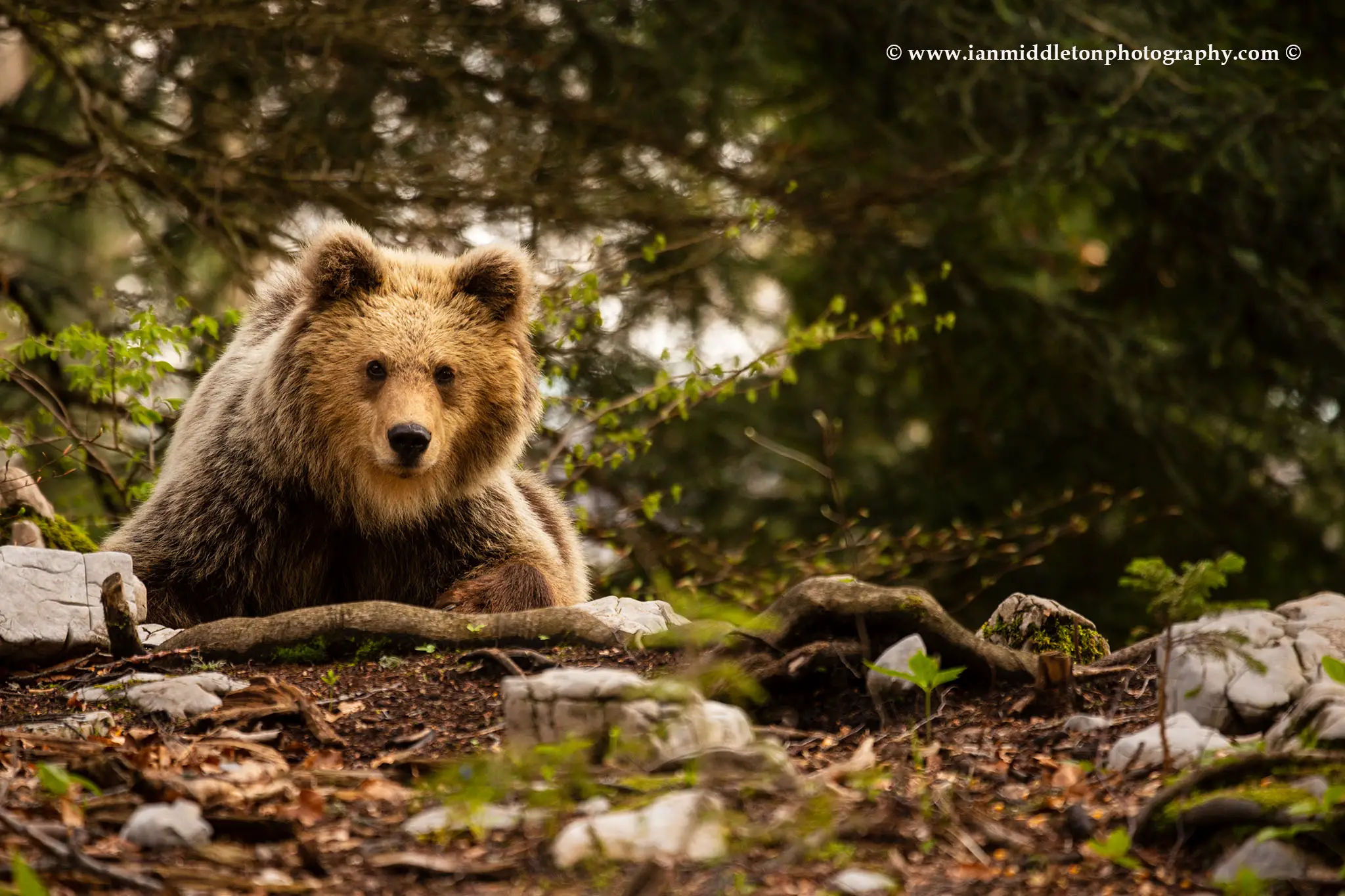
Combining his passion for bears and photography
Having spent his childhood roaming the forests of Snežnik, Miha secretly watched all the wild animals as they went about their daily lives, including brown bears. He got to know their patterns, habits and more importantly learned to read their traces. Brown bears are most common in this part of Slovenia, and encounters with the king of the Slovenian forest have left an indelible mark upon him.
A fortuitous meeting with two renowned Italian photographers sent Miha on his path to photographing bears and other wildlife himself. This subsequently led him to his idea for building special photographic hides in order to ensure a safe environment for both the bear and the photographer.
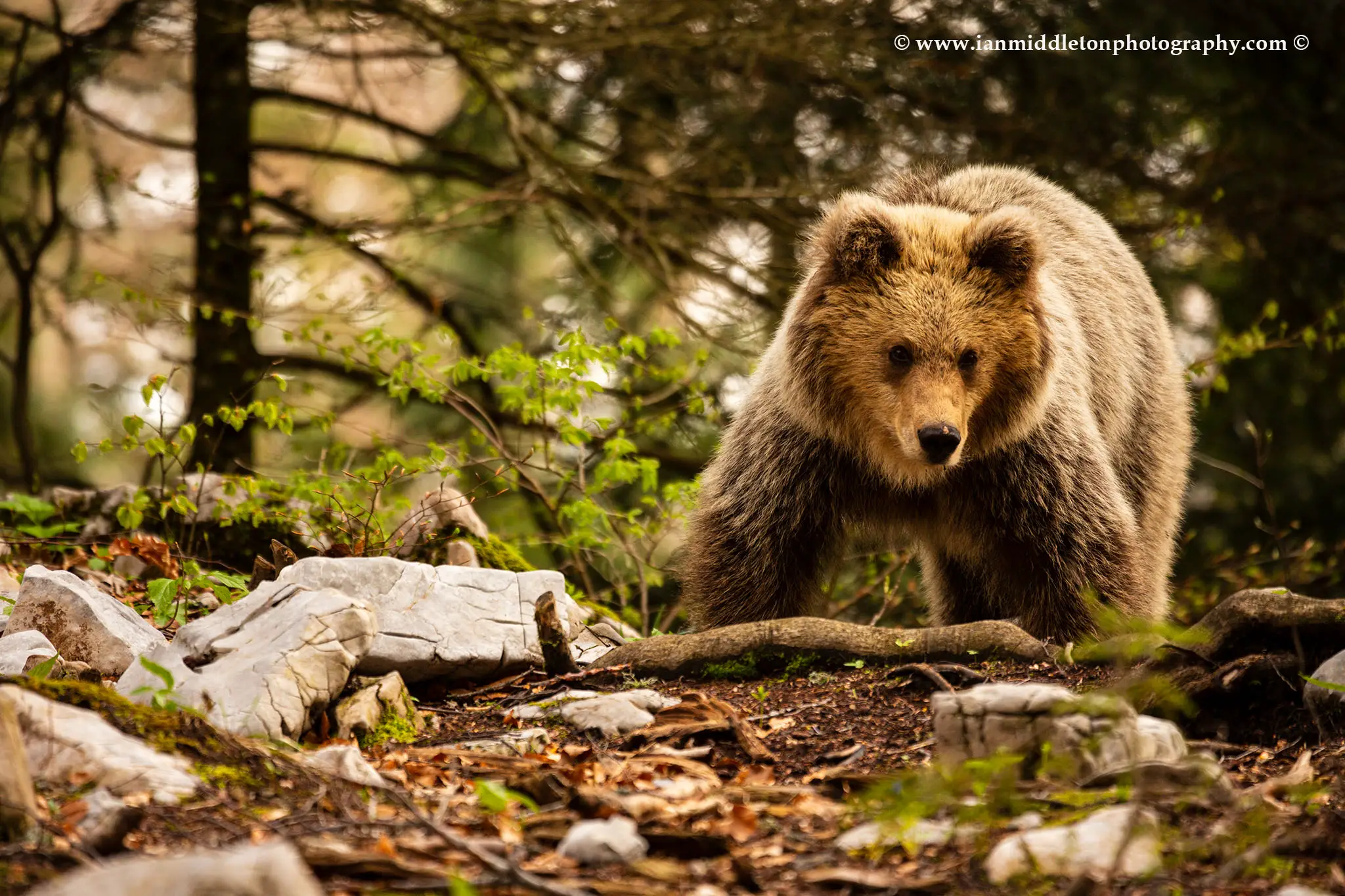
The best combination of knowledge
By combining his years of knowledge and experience watching and tracking the bear’s habits with his newfound knowledge and skills as a photographer, Miha has pioneered the way for nature and wildlife photographers to visit Slovenia and capture these elusive creatures in all their wonder and glory. Not only does he know how to build a hide that would be safe for both the occupant and the bear, but he also knows exactly what photographers need inside to maximise their chances of capturing great bear photos.
Miha’s intimate knowledge of the bears, their movements, habits and habitat means he knows in which locations you are most likely to have a sighting. His knowledge of photography has helped him decide where to place the hides in order to make use of the best afternoon and morning light. A limited amount of food, corn, is placed in specially selected areas. These areas, along with the hide placements, have also been chosen for optimum light and with the photo angle in mind. The viewing windows are aligned as much as possible for a straight on view rather than looking down. When photographing wildlife, you need to get down to the animal’s level.
The locations of these hides and feeding areas have also been selected in cooperation with the hunting organisation. This ensures the same locations are used throughout. The amount of feeding areas and food is strictly regulated by the Slovene authorities. While it may seem controversial, feeding of the bears and other wildlife has long been a tradition in Slovenia and other European countries. Feeding helps keep track of numbers and control the population, but more importantly reduces the chances of human contact by helping to ensure hungry bears do not stray into inhabited areas. Additionally, this feeding cycle increases the chance of sighting and photographing bears from Miha’s hides. Therefore, as you can see, everything is done in perfect harmony.
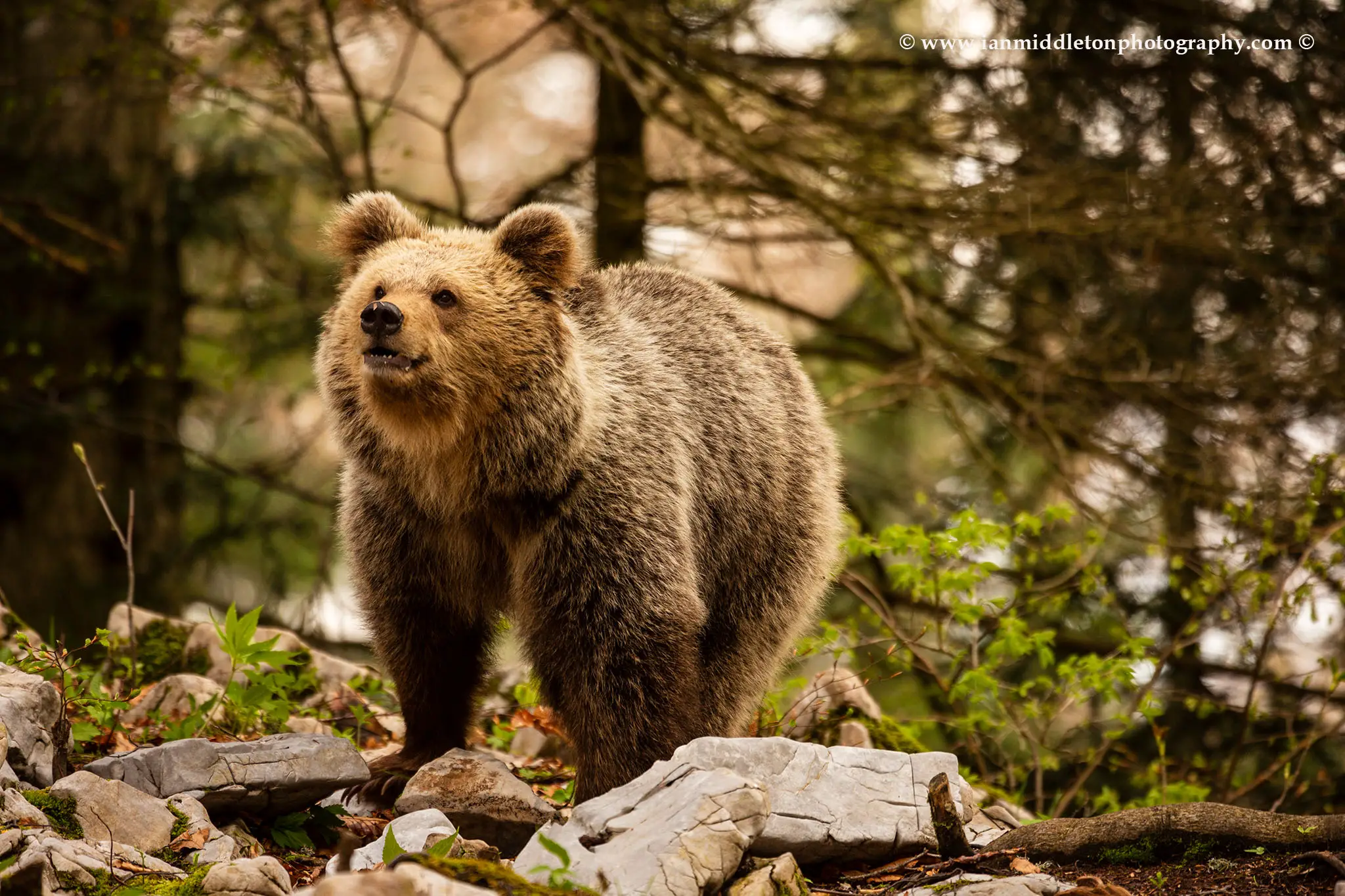
Return to the forest
Back in May 2015, when I ventured down to his base in Markovec to embark upon my first long-awaited experience photographing bears in Slovenia, Miha had only recently begun building his special photographic hides and thus his Slovenian Bears business. He started in 2014 and based it, quite naturally, at the family guesthouse, Mlakar Inn. Accommodation is also offered in conjunction with your bear experience, along with home-cooked food before and after. You can choose to book a photo hide for one day, or several days. Or you can go on one of the many multi-day trips he offers for the chance to capture mothers and their newborns.
On my first visit, I was able to photograph two young brothers, and two big bears. Within an hour of entering the hide, the brothers came and spent at least two hours frolicking in woodland before us. I came away with some great shots.
Upon my return this year, 7 years later, Miha now has a grand total of 36 hides placed in strategic locations within the densely forested regions of Notranjska and Kočevje. The hides are scattered throughout an area covering 30 x 20kms. Obviously as demand has grown, Miha has also collaborated with other guesthouses around the region to offer food and accommodation for the trips. I was invited to join Miha and two Italian photographers at the lovely Gostišče Ana in Retje, Loški Potok, where lunch was waiting.
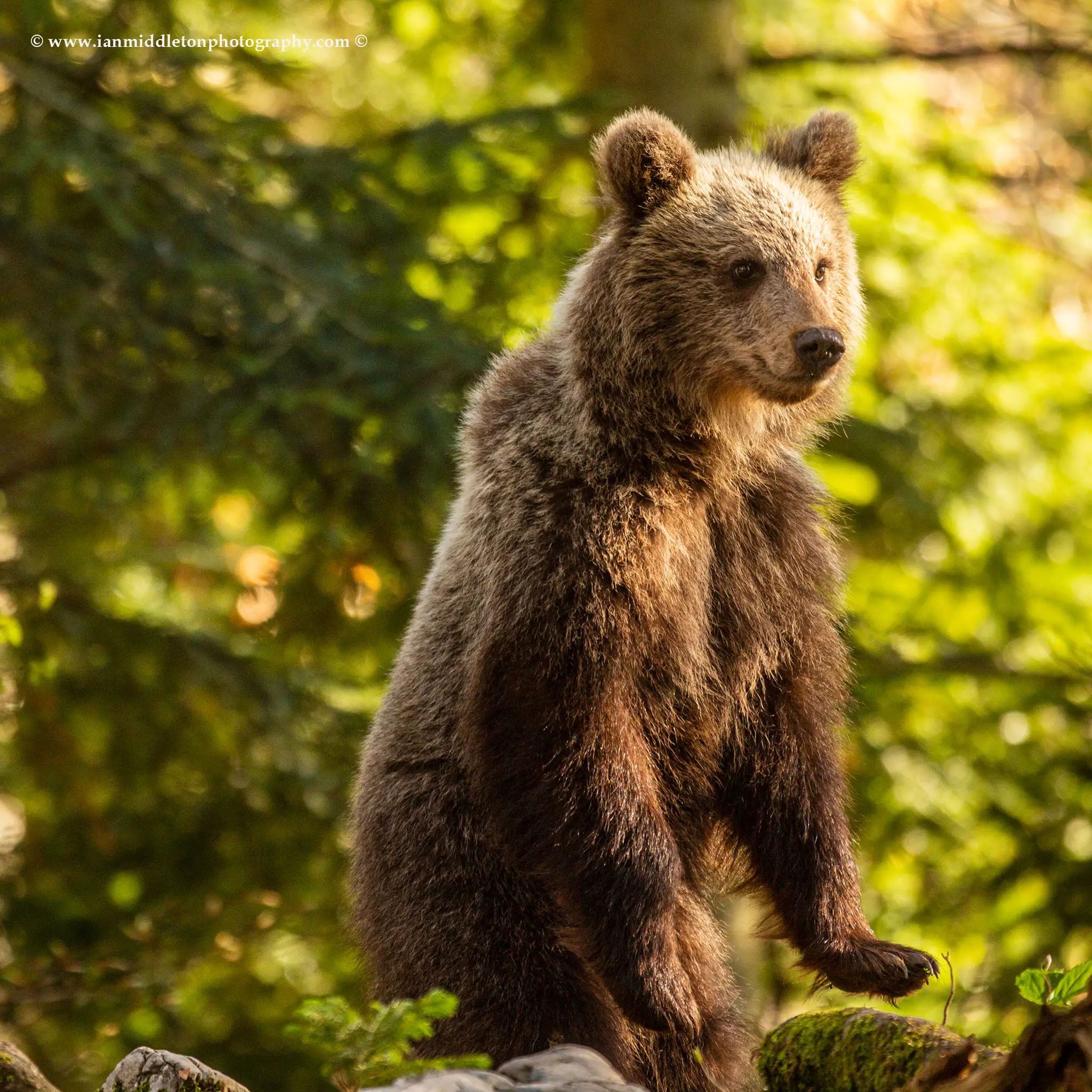
Being well prepared
“Do you have a tripod with you?” asked Miha.
“Yes, I do.” I replied. Thankfully I always take it with me, even if I think I won’t need it.
“Bring the head,” he told me. “I have made special wooden blocks you can attach it to.
This was, as it turned out, an ingenious idea.
As we drove off in the car to where we would start our short walk to the hide, Miha gave everyone a rundown of the rules and etiquette, which are not only designed to protect the photographer but also the bears. Once in the hide, no one must leave until Miha comes back. Absolute silence must be maintained at all times. This also means considering the use of controls on our camera.
“Turn off the focus beep, and the focus light,” said Miha. “Strictly no flash photography. And also turn off continuous shoot. Just one shot at a time, otherwise the noise will scare off the bear.”
Miha went on to explain how to behave when a bear comes. “Don’t start photographing right away. The bear will approach cautiously, and first will be very alert to any possible danger. It will scout the area and only start to eat when it feels safe. Wait for the bear to settle and start eating before taking any photos. Also, don’t photograph birds or any other animals while waiting for the bears, as they may be nearby and be scared off before they arrive.”
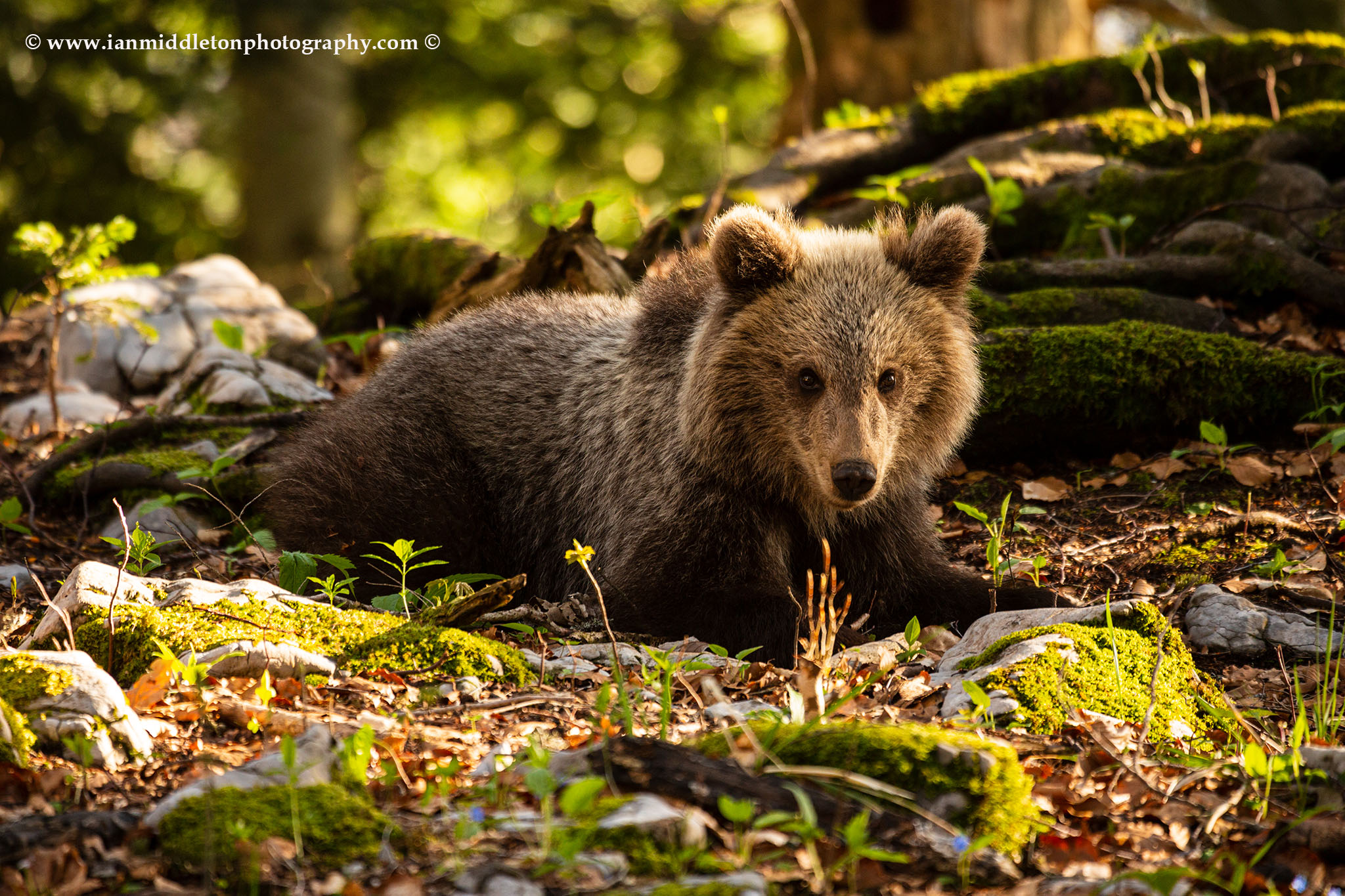
Tracking the bears
Miha drove us deep into the forest along a dirt road before stopping at a small lay-by. From here it was a relatively short walk to the hides. Along the way, he stopped to look at one of the many cameras he has strapped to a tree. While he is an expert tracker, he also now makes use of modern technology.
These cameras are strategically placed around his hides. Any movement triggers a sensor and the camera starts taking photos, some of which are sent to Miha's phone. The cameras also have infra red (IR) capability for night shots. This is a very effective way of monitoring activity around his hides, which of course allows him to choose the best hides for the photographers. Naturally, this increases the chances of a sighting on the day. The camera showed a lot of activity that very morning, so the chances were good.
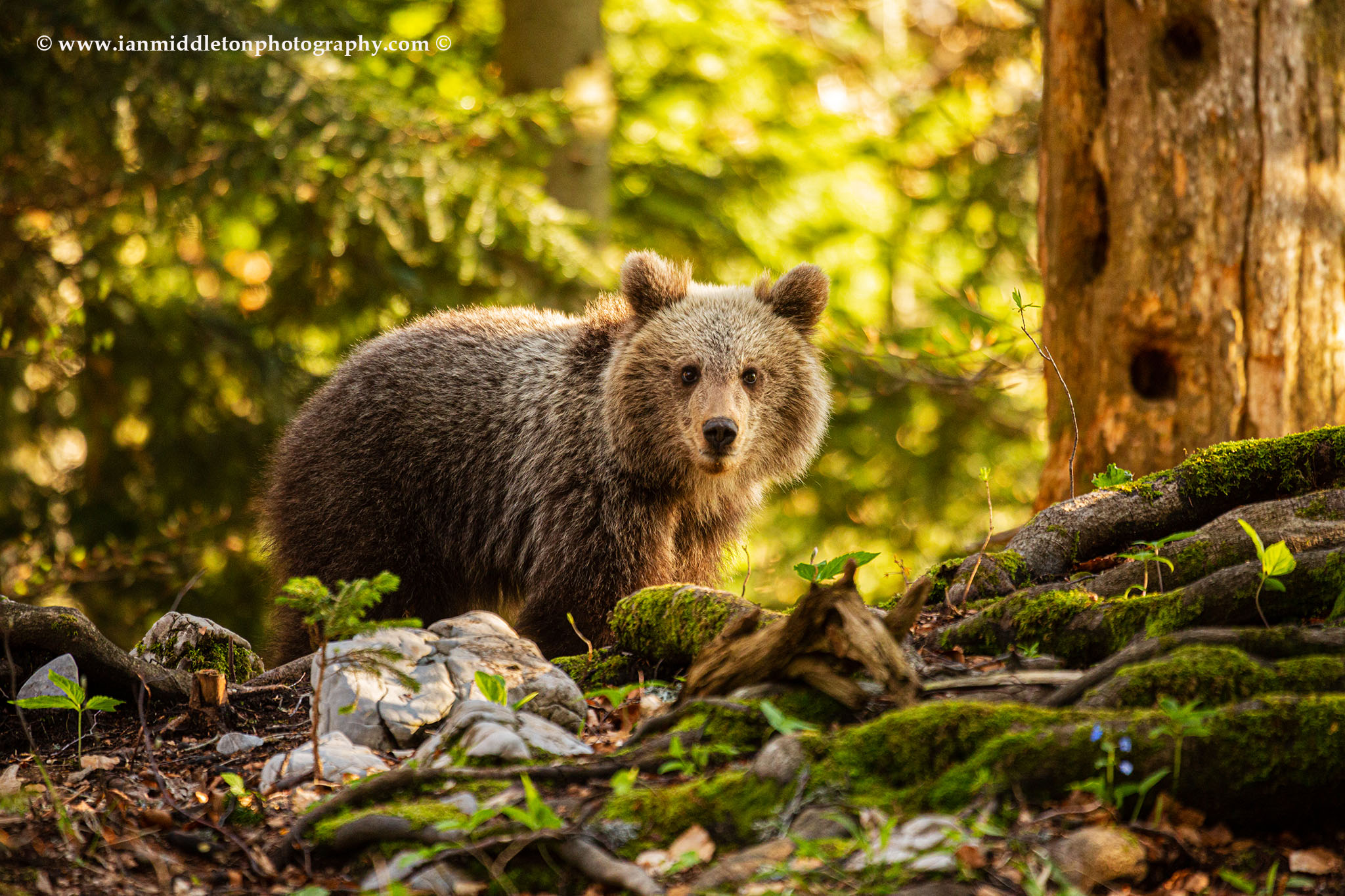
Into the hide we go
There were three of us, and we were given a hide each. We checked our mobile signals to ensure we could contact Miha in case of an emergency, and he also gently reminded us to put our phones on silent. Once inside, I screwed my tripod head to the wooden block and setup my camera. The hides are designed for photographers. Along with the windows there are special camera holes with a cover you place over your camera. Then you put the lens through the cover hole so only the lens is poking out. The rest of you and your camera are camouflaged.
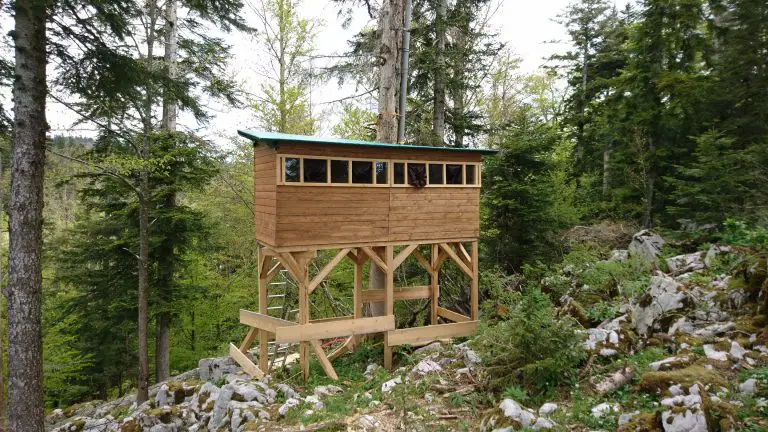
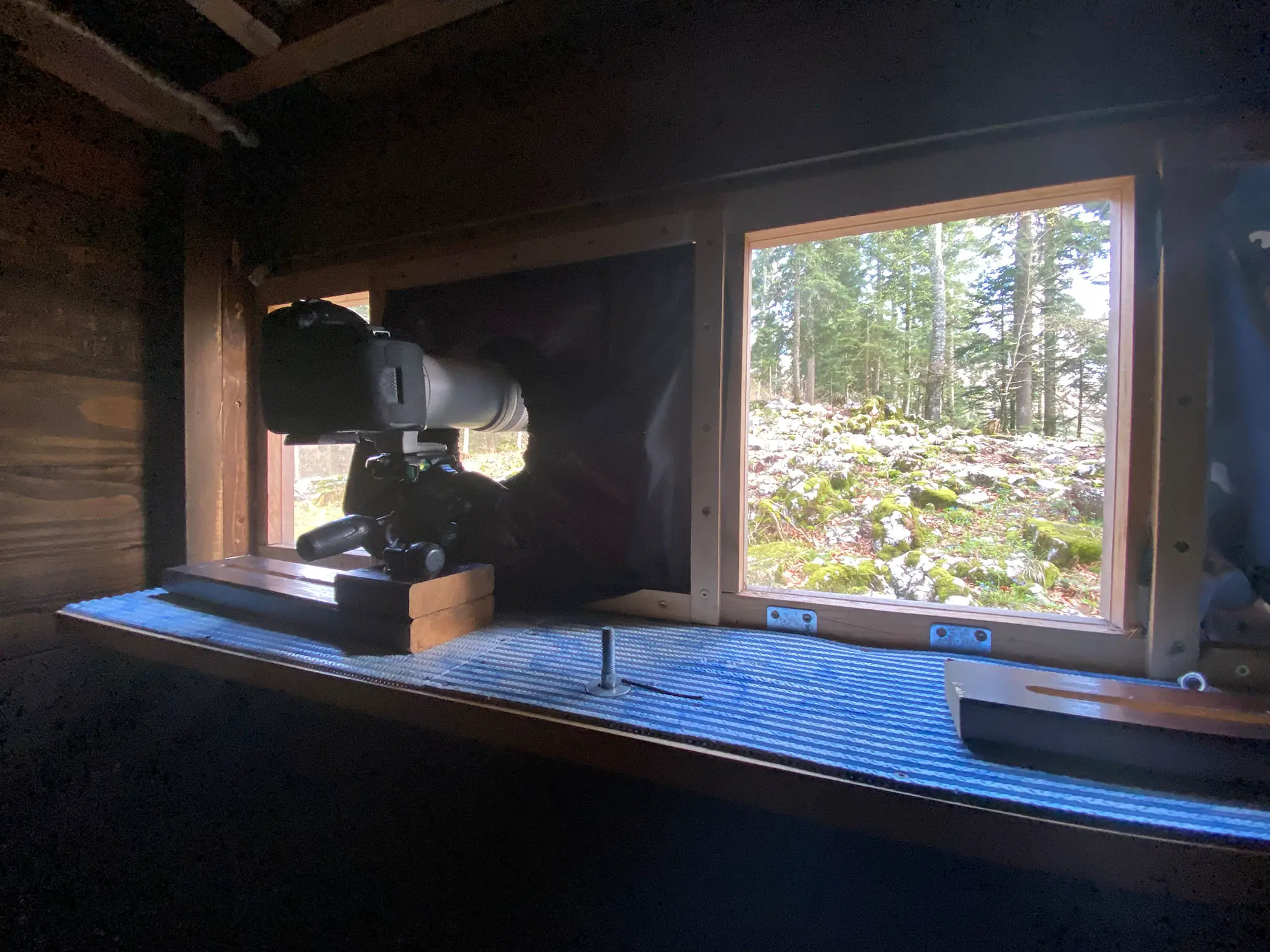
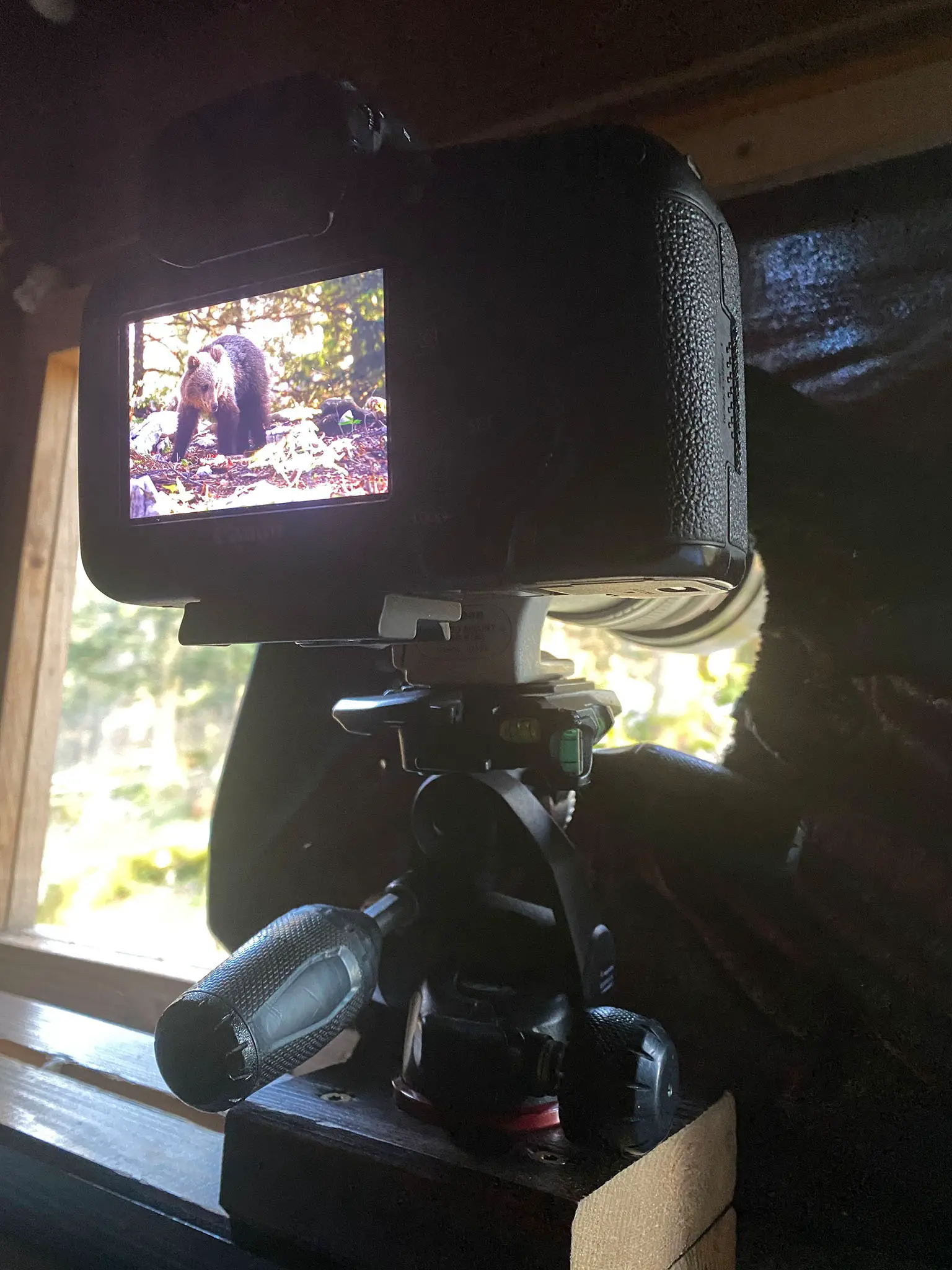
Equipment
The feeding area here is around 10-20 metres away. Photography distances vary from hide to hide, but they are around 10-50m. On my shoot back in 2015 we were also about 10-20 metres away.
Now I’m not normally one to talk about people needing great equipment for taking photographs, but there are times when a certain type of camera and lens are necessary. Given the distance, and the varying distance, a good zoom lens is essential; ideally a 100-400mm or anything up to 500mm or more.
I used the Canon EF 100-400mm f/4.5-5.6L IS USM. At 400mm, this lens allowed me to get close to the bears, while also being able to pull back and show the bear in its surroundings. A good quality lens is important too, although you can make do with a lower end one if that is all you have. But given this unique opportunity, my advice is to either borrow a higher quality lens from a friend, or rent one.
A good camera body is essential too. I was using the Canon EOS 5Dm3. Photographing wildlife in the forest can often mean low light levels, so in many cases you will need to increase the ISO to get a fast enough shutter speed. Therefore, a camera that can perform well in low light and offer low noise at high ISOs is essential. The stability provided by the tripod head attachment meant that the risk of camera shake was significantly reduced. An alternative here is to use a beanbag.
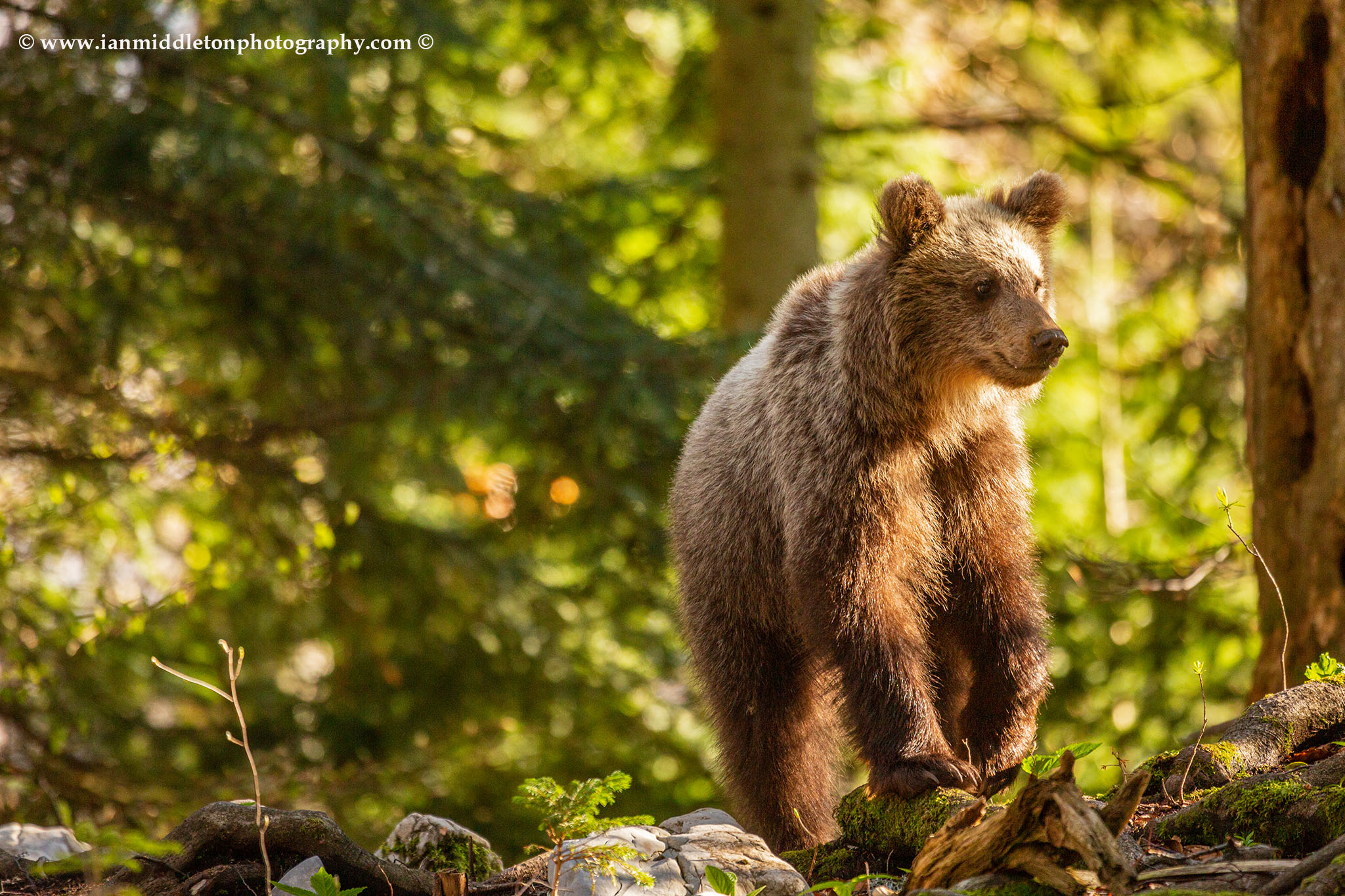
How to get the best photos
We entered the hides around 2pm, and at 4pm we got our first visitor, an adult bear. The morning rain had cleared away and now we had a lovely afternoon of patchy sunlight. The urge to start shooting was overwhelming. However, I heeded Miha’s instructions and waited patiently for the bear to feel safe. It was clear that the bear was on edge, and you could see how it was alert and scouting the area to ensure it was safe. When it started eating, I started photographing.
This is where Miha’s knowledge of photography pays dividends. The light was breaking through the trees and spotlighting the exact areas where the food had been laid out. The bear lifted his head high to smell the area, and beautiful soft light illuminated his face. My first shots were magical, and we had only just begun.
Shortly after though, something obviously spooked the bear and it ran off into the forest. Just goes to show how timid even the big ones are. However, this was just the beginning. A little while later, two bears came together and after settling down were obviously more at ease because they stayed for quite a while, offering numerous photo opportunities.
When they left, a short wait later our smallest visitor yet came by. Hard to say how old, but it was alone so maybe 2-3 years old. This cute little fella seemed to enjoy having the place to himself and also remained for quite a while.
Miha returned for us around 7.30. I had seen four bears that day. Apparently, unbeknown to me at the time, there were two more down to the left just before he came. I hadn’t been able to see them from my hide, but the two Italians had. When Miha came he whistled and called out. Partly to tell us it was him coming, and also to warn any bears of his approach I assume. These two bears ran off when they heard him.
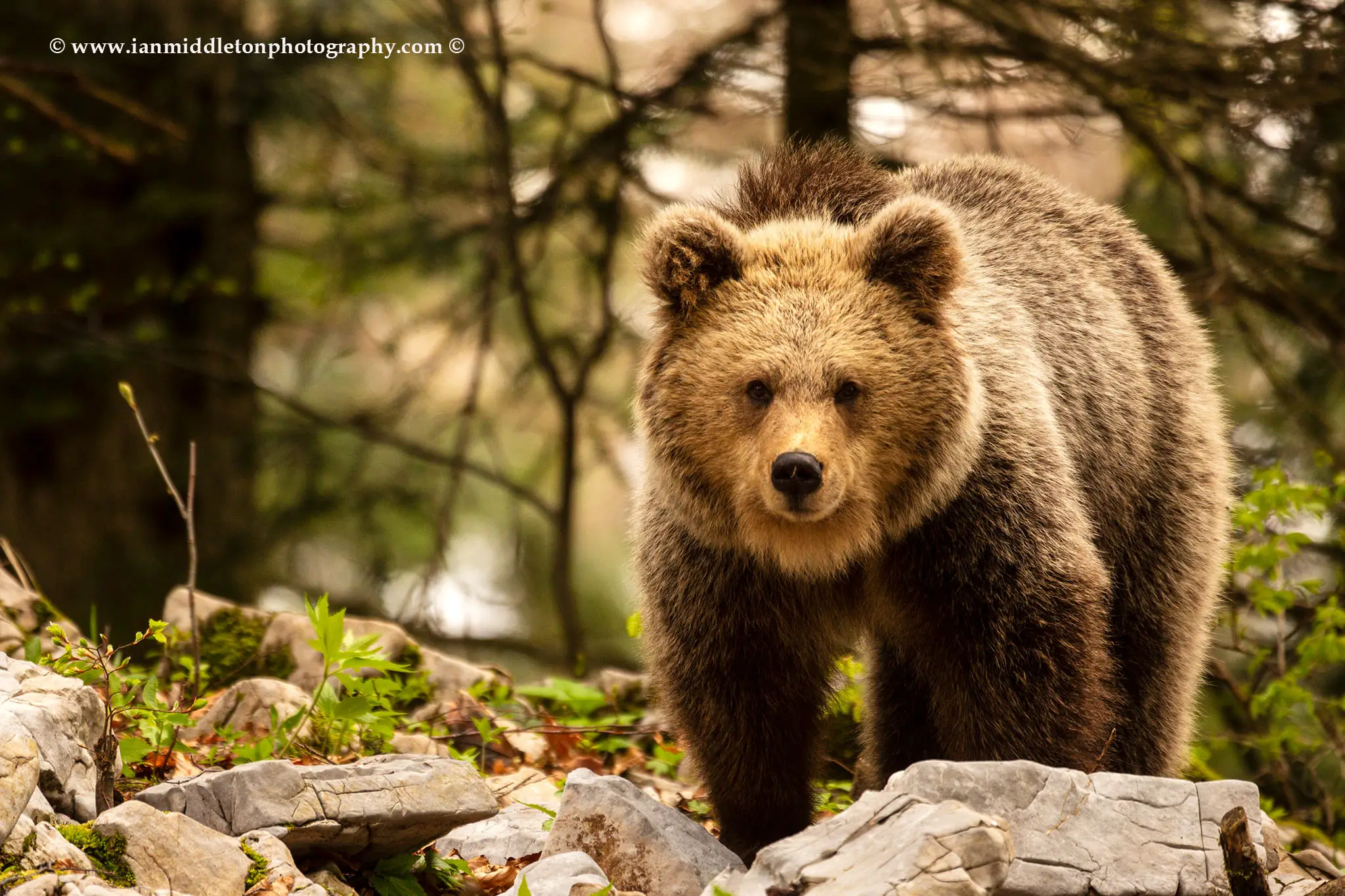
Bear safety
Bear attacks are rare, and in most cases usually the result of a bear being startled or someone getting between a mother and her cubs. This usually happens when people are not making any noise. Bird watchers are especially at risk because they are creeping around the forest trying not to disturb the birds. The general rule of safety when out walking in the forest is to be mindful of this and conscious of making your presence known. If you are with others, then talk. Walk with a heavy footfall. If you are alone, take a stick and bang occasionally on trees or branches or hang a small bell on your backpack.
Bears have an acute sense of smell and hearing, so it’s highly likely they will smell or hear you before you see them; in which case they will move away. Going out alone to take photos is dangerous, and you risk startling a bear. Therefore, going with a specialised organisation like Slovenian Bears is the best and safest way.
As you have also seen here, you will be far more successful and able to photograph more bears than you would if you try it alone. Plus, you won’t hurt yourself or any bears. It’s important to remember that if a bear does attack a human, it’s not only the person who gets hurt or killed, but the bear is then scheduled for termination and the hunters must track down and shoot it.
Do you really want to give yourself and a bear a death sentence?
Responsible tourism
Although Miha has 36 hides, they are not all in constant use. The Slovenian Bears ethos is to minimise the impact on the bears and their habitat. Therefore use of hides is rotated to ensure the bears have peace and quiet as much as possible. This also helps to ensure the bears get to know this location as a safe and reliable source of food, thus maximising the chance of their return and your chance of spotting them.
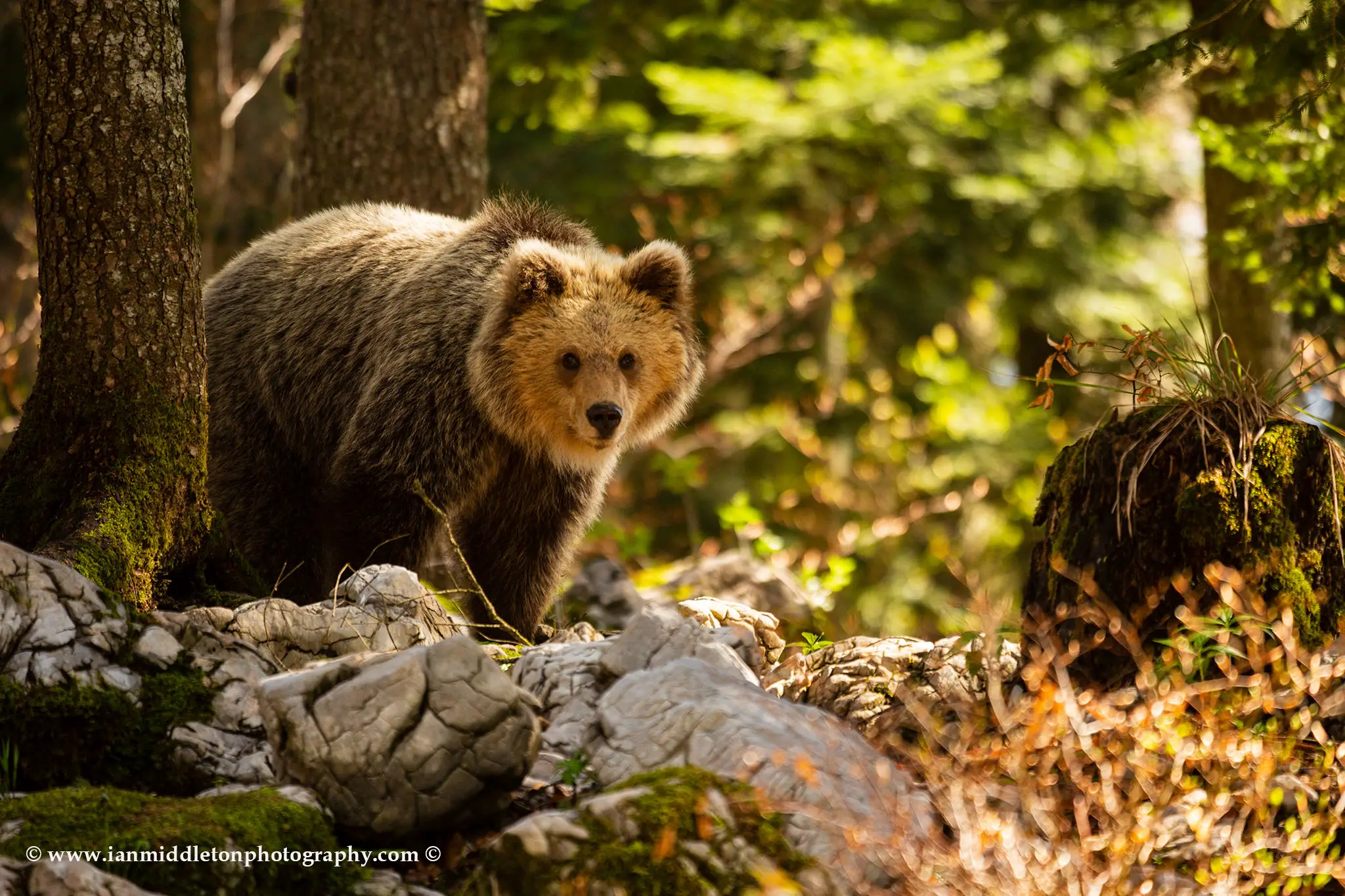
The best way to photograph bears
So as you can see, without doubt the best way to photograph bears in Slovenia is with Slovenian Bears for both safety and reliability. When it comes to viewing wildlife there is never a 100% guarantee, but Miha’s superb setup ensures the highest rate of success.
For more information contact Miha Mlakar: Website: slovenianbears.com / Email: This email address is being protected from spambots. You need JavaScript enabled to view it. / Tel: 041 582081
STA, 13 August 2021 - As many as 130 brown bears were culled in Slovenia this year until 11 August, of which 121 were hunted on the basis of the Environment Agency's permits and nine were found dead, the Environment Ministry told the STA on Friday, four days after a brown bear attacked a local while he was jogging near the town of Pivka, SW.
Monday's attack was examined by Slovenia Forest Service experts, who established that the 30-year-old must have surprised the she-bear, which had no other way to escape than in his direction.
The bear attacked him, he fought back, which made the bear retreat but she returned and attacked again. The man sustained injuries on his head, neck and arms, and broke his wrist while fighting the bear. He was then taken to hospital, but his injuries were not life-threatening, the victim's father told the press this week.
After inspecting the site of the attack, the Forest Service did not issue an opinion on culling, so the Environment Agency has not issued a culling permit.
The Environment Ministry said that the country's brown bear population "is favourable with an improving trend".
The 2020-2023 brown bear management guidelines say that the country's 2020 bear population in spring, which is the highest within a year, is 990, while its actual number is probably between 860 and 1,120.
Brown bear can present a physical threat to people, but attacks are relatively rare. Forest Service data shows there are an average two attacks annually.
However, there are several "make believe" attacks when a bear chases a person only to scare them, but then stops, it does not attack, Peter Krma from Forest Service has told the newspaper Primorske Novice.
This week's was the first reported bear attack on a human in Slovenia after May 2020, when a 56-year-old man stumbled upon a bear in the woods near Škofljica, just south of Ljubljana.
STA, 8 July 2021 - Slovenian authorities dealt with more incidents of damage caused by bears and fewer by wolves in January-June compared to the same six-month period last year, while the total damage is lower. A total of 128 bears were culled in this period, a significant rise from a total of 99 culled in the entire 2020.
In the first six months of 2021, authorities dealt with 120 cases of damage caused by brown bears and 80 cases of damage caused by wolves. Data the STA obtained from the Slovenian Forest Service shows the total damage is estimated at just under EUR 90,000.
In the first six months of last year, there were 86 such events linked to bears and 143 to wolves, with the total damage estimated at EUR 112,000.
Both last year and this year, the most damage was caused in the region of Bela Krajina, south-east, and in the area around Kočevje, south.
128 bears have been culled this year, of which 112 were shot under a permit issued by the Slovenian Environment Agency, seven were shot under individual culling permits, and the rest died in railway or road accidents.
Only four wolves have been culled so far this year - two were shot under individual permits, one was killed on the road, and one is suspected to have been poached. Last year, a total of 99 brown bears and 14 wolves or wolf-dog hybrids were culled, according to the Forest Service data.
The Forest service estimates that more than 1,000 bears live in Slovenia. The number of wolves has been estimated at 113 for the 2019/20 season, and the estimate for the 2020/21 season will be known in the autumn.
STA, 13 November 2020 - Farmers reported fewer attacks on livestock by wolves and bears this year compared with 2019, with wolves causing more damage than bears. The agriculture chamber says this is a result of wolves not being regularly culled for several years now, whereas emergency hunting is not effective enough.
Bears meanwhile seem to be happy with this year's abundant food in forests, which has partly reduced conflicts with humans and their property, the Chamber of Agriculture and Forestry (KGZS) has told the STA.
Nevertheless, the management of large wild animals remains very difficult, since it takes rather long to get a decision on emergency wolf and bear cull if the safety of people is not at stake, the chamber explains.
It continues to urge regular, quota-based hunting as a means of big wild animals management, adding that farmers and rural areas will pay the highest price as the country is struggling to set up a system acceptable to all.
As many as 87 fewer damage cases involving bears and 40 fewer involving wolves were reported in the January-September period compared with the same nine months in 2019.
A total of 228 cases of bear-caused damage valued at EUR 75,000 were reported this year as opposed to 315 and EUR 108,00, respectively, in the same period in 2019.
Data from the Slovenia Forest Service for wolves shows a drop from 299 to 259 cases, with the damage reported down from EUR 207,000 to EUR 126,000.
The wolves and bears most frequently attacked livestock in the heavily forested area around Kočevje in the south, and in Primorska, west, and Notranjska, south-west.
The Environment Agency, which processes the damage claims, received 447 such claims by the end of October, of which 237 were related to wolves and 210 to brown bears.
As many as 157 claims were endorsed and EUR 87,000 in damages paid out, while slightly more than 260 claims amounting to almost EUR 90,000 are still being processed.
With both wolf and brown bear being protected endangered species, several attempts to regulate their growing populations have failed due to opposition by environmentalists.
Nevertheless, wolves and bears continue to be "removed from nature", including on the basis of decisions issued by the Environment Agency.
Twelve wolves were removed this year, up five from the same period last year. This compares to a total of 20 wolves culled last year.
The figures for bears for the nine months is 99, compared with 153 in the same period last year and a total of 183 bears culled in entire 2019.
This year the government plans to start changing the 2009 strategy on the preservation and sustainable management of wolves as part of the Life WolfAlps EU project.
A strategy on bear management was meanwhile subject to public consultation this year and is expected to be adopted next year, the Environment Ministry has told the STA.
Jackal is another wild animal causing damage to farmers, mostly in SW, with 88 damage cases being reported for the nine months, up 11 from the same period in 2019.
While 197 jackals are planned to be removed from nature this year, 145 have been removed between 1 July, when the hunting season opened, and 10 November.
STA, 12 June 2020 - The Agency for the Environment has issued a permit for the culling of 115 brown bears until September this year across multiple parts of Slovenia that are home to a large brown bear population.
Culling has long been the main way in which the Slovenian brown bear population has been kept in check and the Environment Agency said on Friday there was "no other satisfactory possibility" and that the cull "does not harm the preservation of the favourable state of the population".
The cull will be undertaken to mitigate human-bear conflicts in areas where the density of the bear population is high. According to the agency's data, in some parts of south Slovenia densities can be as high as one animal per two square kilometres, among the highest in the world.
Human-bear conflicts have been on the rise in recent years, in particular in areas with a high density of bears and in the vicinity of human settlements. Without intervention, conflicts would only increase.
The latest estimates, for 2020, put Slovenia's brown bear population, which is a part of a large Dinaric population that stretches across Slovenia, Croatia and Bosnia-Herzegovina, at 860-1,120 animals, the agency said.
Brown bear culling has long been a controversial measure and environmentalists have been fighting it in court year after year.
But the scientific consensus is that the population is thriving and must be controlled so as to prevent conflicts from escalating, which may ultimately undermine public acceptance of the very existence of a population of large carnivores in the country.
STA, 7 May 2020 - A 56-year-old man strolling in the woods near Škofljica, just south of Ljubljana, stumbled upon a bear, who attacked him, media have reported. The man reportedly surprised the animal and used his hands and a walking stick to defend himself, the Forests Institute told the STA. Police say the man's injuries are not life-threatening.
The man was strolling in the woods between the villages of Klada and Želimlje on Tuesday evening when he stumbled upon the bear.
According to the Forests Institute, the man did nothing to provoke the attack but he obviously came too close to the animal.
The 56-year-old returned home in shock and with multiple wounds on the upper part of his body. His family immediately took him to the hospital, where it was determined that he had only sustained light injuries and had no bite wounds.
The site of the incident was thoroughly checked and is still being monitored by the local hunting association. Police too are investigating the incident.
If the bear continues to come close to humans, showing no fear, the association said it would ask the Environment Agency for permission to shoot the animal.
A bear attack happened in the same area last June. Back then an 80-year old woman was the victim of a female bear, which was not killed after the incident.
On average, two bear attacks on humans are recorded in Slovenia every year. People do not encounter the beast frequently, as bears usually avoid contact with humans.
Encounters are the most frequent in the spring, when bears emerge from their dens after winter sleep and more people are out in the woods, as well as in the summer and autumn when people pick forest fruit and mushrooms.
Bears usually cause light injuries to humans, such as scratches and bites. Fatal injuries are rare. In Slovenia, three such cases have been recorded so far, the last one in 1987.
STA, 20 April 2020 - The Constitutional Court has repealed an emergency law ordering the culling of brown bear and wolf populations which was to remain valid until late September. Even though the cull determined by the law has already been carried out, the decision may prevent the adoption of emerging amendments that would increase the cull quota for this year.
The court has ruled that the law is in violation of Article 3 of the Constitution, which refers to the separation of powers between the three branches of government. Based on that, it did not rule on the substance of the law, said Alpe Adria Green, an environmental NGO.
The law gave permission to hunters to cull 175 bears and 11 wolves. Most of the animals have already been culled, but the NGO says the ruling would probably put a stop to an amendment to the act currently under discussion which would enforce additional culling.
A constitutional review of the bill was sought by the Legal-Informational Centre for NGOs and the Association for the Preservation of Slovenian Natural Heritage in July. The court agreed at the time that any culling should be regulated by the nature conservation act and the decree on protected wild animal species, while the culling should be ordered by the government.
After the Administrative Court annulled a number of such government decrees, parliament passed a law directly mandating the cull, a move that the Constitutional Court sees as violation of the principle of the separation of powers.
Since the legislation was to expire at the end of September, efforts to amend the act have begun. The changes, which were proposed by the National Council in February and enjoy support from the government, would expand the annual cull: 220 bears were to be killed between 1 May and 30 April 2021 and 30 wolves from May to late January 2021.
More than 30 environmental NGOs have protested against the proposal, addressing a letter to the EU Commission representation office and European Parliament office in Slovenia and urging the authorities to immediately impose a moratorium on carnivore culling in the country.
Slovenia has a thriving brown bear population that was estimated at 750-975 animals at the end of 2018 under a study conducted in the framework of the international project LIFE. Culling is a widely accepted management practice supported by researchers, but in recent years the public pressure to control the population has increased due to a growing number of human-bear conflicts.
The wolf population, meanwhile, is estimated at around 80 animals, according to a study commissioned by the Agriculture Ministry. Damage by wolves, in particular to livestock, has been increasing in recent years, but experts say culling must be very precise in order not to disturb the hierarchy of wolf packs, which may actually cause greater damage if packs are unstable.
STA, 26 February 2020 - With spring approaching, farmers in areas that have seen an influx in bear and wolf attacks in the recent years worry that letting their animals out to pasture would prove fatal despite the emergency measures taken last year to decrease the population of large carnivores in Slovenia.
Between July 2019 and the end of January, the bear population has been reduced by 172 and the wolf population by 11, nearly on target with an emergency law passed last year. Specially authorised hunters shot 161 bears and four wolves, the rest died due to other reasons.
Nonetheless, 22 attacks on sheep, cattle and horses have been reported this year so far, the Environment Ministry told the STA.
No additional culling measures are planned at this point, and large carnivores can only be shot if they pose significant threat to humans and property, and under strict rules.
What is more, the Environment Ministry must draft a new quota reasoning for bears after an environmental NGO successfully challenged the previous one in administrative court in April 2019.
The ministry told the STA that the reasoning would be based on proving that the number of conflicts continued to increase despite measures addressing cohabitation issues.
The reasoning will also have to submit scientific proof that the planned cull quota will ensure an appropriate decrease in population to lower or stop the increase in conflicts.
Last year, bears attacked 461 times and wolves 327 times. Expert estimates suggested that some 1,000 bears lived in Slovenia last year and about 80 wolves.
Now, farmers in the woody Kočevje area are worried that they will face the same problems as last year once they let their animals out to pasture this spring.
"We are afraid that wolves will kill [our sheep] and we will lose everything. Many farmers have heard wolves gathering around sheep pens already," the civil initiative Aktivna Kočevska has said in a letter addressed to Agriculture Minister Aleksandra Pivec.
They demand that the population of large carnivores be reduced to "numbers acceptable to the environment", which they believe was last the case in 1999 and 2000.
First step to this end may be made today, as the upper chamber of parliament, the National Council, discusses another emergency bill for the culling of large carnivores drafted by one of the national councillors.
All our stories about wolves are here, and those about bears are here
STA, 22 January 2020 - Slovenia has sought to convince the European Commission to loosen rules on the protection of large carnivores when populations of the animals are booming, but EU officials appear to have poured cold water on the idea at a meeting at the Environment Ministry this week.
The Brussels officials said the key goal of European policies was cohabitation with large carnivores, which means prioritising protective measures and paying out compensation in the event of livestock loss.
"The extreme measure in the event protective measures are not working is culling, provided ... that the favourable state of the population is being maintained and does not worsen," the ministry said in a press release on Wednesday.
It is the job of the state to strengthen communication and awareness raising, especially in the countryside and in areas where populations of large carnivores are growing, the EU officials were quoted as saying.
The statement came a day after the ministry organised a meeting on Tuesday featuring EU officials and the members of a national task force for the management of brown bear, wolf and lynx.
The populations of brown bear and wolf have been expanding in Slovenia in recent years, leading to push-back from locals living in affected areas and demands that culling, the principal management measure used in Slovenia, be intensified.
In 2019 just over 170 bears were culled out of a rapidly rising population that is estimated to number just under 1,000 animals, and five of the estimated 88 wolves on Slovenian territory.
But despite the extensive culling, Slovenia had sought additional loosening of EU-wide rules on protected species to make it even easier to control the population.
Environment Minister Simon Zajc thus called for a more flexible approach at an EU ministerial in December, with the argument that the specifics of each country ought to be taken into account.
The EU officials have now said that no such change is currently planned. Procedures may be initiated assuming such motions are backed by hard science, but the procedure is exceptionally long, the Environment Ministry said in a release after the meeting.
All our stories on bears in Slovenia are here




